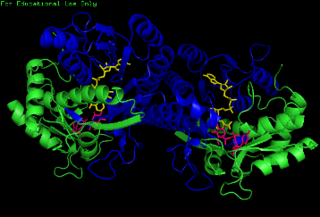
Mucins are a family of high molecular weight, heavily glycosylated proteins (glycoconjugates) produced by epithelial tissues in most animals. Mucins' key characteristic is their ability to form gels; therefore they are a key component in most gel-like secretions, serving functions from lubrication to cell signalling to forming chemical barriers. They often take an inhibitory role. Some mucins are associated with controlling mineralization, including nacre formation in mollusks, calcification in echinoderms and bone formation in vertebrates. They bind to pathogens as part of the immune system. Overexpression of the mucin proteins, especially MUC1, is associated with many types of cancer.

The enzyme UDP-glucose 4-epimerase, also known as UDP-galactose 4-epimerase or GALE, is a homodimeric epimerase found in bacterial, fungal, plant, and mammalian cells. This enzyme performs the final step in the Leloir pathway of galactose metabolism, catalyzing the reversible conversion of UDP-galactose to UDP-glucose. GALE tightly binds nicotinamide adenine dinucleotide (NAD+), a co-factor required for catalytic activity.

Histatin 3, also known as HTN3, is a protein which in humans is encoded by the HTN3 gene.

Statherin is a protein in humans that is encoded by the STATH gene. It prevents the precipitation of calcium phosphate in saliva, maintaining a high calcium level in saliva available for remineralisation of tooth enamel and high phosphate levels for buffering.

Polypeptide N-acetylgalactosaminyltransferase 1 is an enzyme that in humans is encoded by the GALNT1 gene.

Histatin-1 is a protein that in humans is encoded by the HTN1 gene.

Alpha-(1,3)-fucosyltransferase is an enzyme that in humans is encoded by the FUT9 gene.

Polypeptide N-acetylgalactosaminyltransferase 2 is an enzyme that in humans is encoded by the GALNT2 gene.

Oviduct-specific glycoprotein also known as oviductal glycoprotein(OGP) or estrogen-dependent oviduct protein, oviductin or mucin-9 is a protein that in humans is encoded by the OVGP1 gene.

UDP-GlcNAc:betaGal beta-1,3-N-acetylglucosaminyltransferase 2 is an enzyme that in humans is encoded by the B3GNT2 gene.

Beta-1,3-galactosyltransferase 5 is an enzyme that in humans is encoded by the B3GALT5 gene.

Polypeptide N-acetylgalactosaminyltransferase 6 is an enzyme that in humans is encoded by the GALNT6 gene.

Polypeptide N-acetylgalactosaminyltransferase 13 is an enzyme that in humans is encoded by the GALNT13 gene.

Chondroitin sulfate N-acetylgalactosaminyltransferase 1 is an enzyme that in humans is encoded by the CSGALNACT1 gene.

Polypeptide N-acetylgalactosaminyltransferase 14 is an enzyme that in humans is encoded by the GALNT14 gene.
Core 1 synthase, glycoprotein-N-acetylgalactosamine 3-beta-galactosyltransferase, 1, also known as C1GALT1, is an enzyme which in humans is encoded by the C1GALT1 gene.
Histatins are histidine-rich (cationic) antimicrobial proteins found in saliva. Histatin's involvement in antimicrobial activities makes histatin part of the innate immune system.
(N-acetylneuraminyl)-galactosylglucosylceramide N-acetylgalactosaminyltransferase is an enzyme with systematic name UDP-N-acetyl-D-galactosamine:1-O-(O- - -O-beta-D-galactopyranosyl- -beta-D-glucopyranosyl)-ceramide 4-beta-N-acetyl-D-galactosaminyltransferase. This enzyme catalyses the following chemical reaction
N-acetyl-beta-glucosaminyl-glycoprotein 4-beta-N-acetylgalactosaminyltransferase is an enzyme with systematic name UDP-N-acetyl-D-galactosamine:N-acetyl-beta-D-glucosaminyl-group 4-beta-N-acetylgalactosaminyltransferase. This enzyme catalyses the following chemical reaction

Proline-rich protein HaeIII subfamily 2 is a protein that in humans is encoded by the PRH2 gene.














